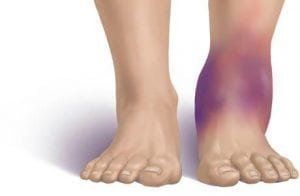This is an automatically translated article.
Compression syndrome is the phenomenon of increased pressure in the soft tissue in the closed cavity, leading to tissue ischemia. The patient feels excessive pain. Diagnosis is based on clinical symptoms and pressure measurement.
1. What is compartment syndrome?
Compression syndrome is a phenomenon of increased soft tissue pressure in the closed cavity leading to tissue ischemia. Comparative compartment syndrome worsens on its own. The initial symptom is usually soft tissue edema, which is very normal after trauma due to soft tissue swelling or hematoma. If edema develops in the closed space, it is more likely to occur in the anterior and posterior compartments of the lower leg where there is little room for the soft tissue to expand. As a result, the cavity pressure will increase. When the pressure exceeds the capillary osmolality by about 8 mm Hg, cell exchange slows down or stops. The ischemia to the tissue causes increased edema, forming a pathological spiral.
As the anemia progresses, muscle necrosis, sometimes leading to rhabdomyolysis, infection, and hypersensitivity, complications that can lead to limb loss and even death if left untreated . Arterial ischemia or low blood pressure can cause edema to increase, forming a pathological spiral.
Compression syndrome mainly occurs in the extremities, especially the forearms and lower legs. However, compartment syndrome can also occur in some other locations such as arms, buttocks, abdomen, ...

Hội chứng chèn ép khoang là hiện tượng tăng áp lực mô mềm trong khoang kín dẫn tới thiếu máu mô
2. Causes of compartment syndrome
Causes of compartment syndrome include:
Trauma: Injuries to blood vessels and soft tissues, fractures account for about 45%, after surgery combined bones, local burial of extremities. Severe crushing, contusion injury Reperfusion injury occurs after vascular damage is repaired Anticoagulation, calcium injection Coagulation disorders Fatty, elderly, and atherosclerotic patient Patient does not cooperation when applying pressure Compression and compression techniques, the process of performing procedures,... Edema, tissue necrosis: snakebite, burns

Dùng thuốc chống đông có thể gây ra hội chứng chèn ép khoang
3. Symptoms of compartment syndrome
Symptoms of compartment syndrome are usually pain, the pain level does not correspond to the level of injury, gradually increasing with passive movement of the muscle group in the cavity. Pain is one of the five signs of tissue ischemia. Subsequent symptoms include:
Paresthesias Paraesthesias pale color loss of blood Tight compartments Symptoms of compartment syndrome are often not used to make a diagnosis because the symptoms are atypical, masked by other symptoms. symptoms of fracture and altered mental status due to other trauma or medication.
4. Diagnosis and treatment
4.1 Diagnosis
The method of diagnosing compartment syndrome is to measure pressure in the cavity. A diagnosis of compartment syndrome is made and treatment is initiated before pallor, blood loss, or signs of necrosis develop.
In patients at risk, the doctor must determine the threshold for the occurrence of compartment syndrome, normal < 8 mmHg, measured with a pressure monitor. Compartment syndrome is defined as intracompartmental pressure > 30 mmHg or only 30 mmHg less than diastolic pressure.
4.2 Treatment
The treatment for compartment syndrome is to open the scale to release the cavity. However, the initial treatment is to remove tight structures such as splints, casts, ... around the limb, adjust blood pressure, relieve pain for the patient and increase oxygen ventilation.
When the compartment pressure decreases rapidly and the clinical symptoms are relieved, the emergency scale should be opened. Weight loss surgery is carried out with a wide skin incision to ensure the opening of all compartments, reducing cavity pressure. Check the viability of the muscles if there is necrotic tissue that requires excision.

Triệu chứng của hội chứng chèn ép khoang thường là đau, mức độ đau không tương ứng với mức độ chấn thương
In summary, compartment syndrome is a phenomenon of increased pressure of soft tissue in the closed cavity, leading to tissue ischemia. The patient feels excessive pain. Diagnosis is based on clinical symptoms and pressure measurement. The disease, if left untreated, can cause dangerous complications such as gangrene and possibly death. Therefore, when you have an injury or have symptoms of cavity compression, you should immediately go to a medical facility for examination and treatment measures.
Vinmec International General Hospital with a system of modern facilities, medical equipment and a team of experts and doctors with many years of experience in medical examination and treatment, patients can rest assured to visit. examination and treatment of compartment syndrome at the Hospital.
Please dial HOTLINE for more information or register for an appointment HERE. Download MyVinmec app to make appointments faster and to manage your bookings easily.
SEE MORE
Acute cardiac tamponade: Causes, symptoms and treatment Cardiac tamponade syndrome: What you need to know Signs you need to take your child to a cardiologist










